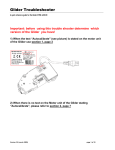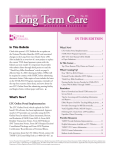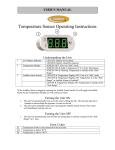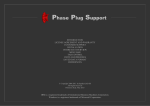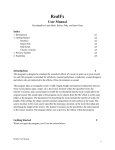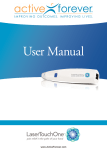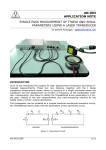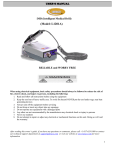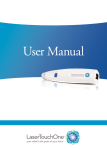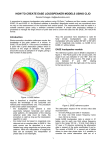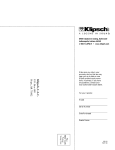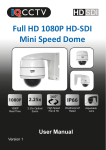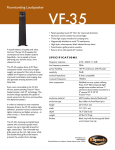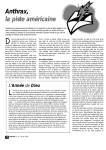Download Horn.ell.a Datasheet
Transcript
Horn.ell.a INTRODUCTION LICENSE AGREEMENT AND WARRANTY CUSTOMER SUPPORT INSTALLATION PROFILE EXAMPLES INTERFACE OVERVIEW MENU BAR TAB CONTROL SHARED VARIABLES BOX UNITS AND PREFIXES SAVED DATA FORMAT REFERENCES © Copyright 2004-2015 by SpeakerLAB Srl All Rights Reserved Printed in Italy, May 2015 IBM is a registered trademark of International Business Machines Corporation. Windows is a registered trademark of Microsoft Corporation. INTRODUCTION ABOUT THIS MANUAL This User's Manual explains the Horn.ell.a software version 1.0.0. WHAT THIS USER MANUAL DOES COVER The Horn.ell.a software is a tool to fast designs 3D Horns. There are thousands of books and papers on many of the topics that Horn.ell.a handles. This User Manual is intended not to explain the horn theory, this issue is left to the reader to explore through large available literature, but only as a guide to allow the user to quickly become efficient with the user interface Horn.ell.a software. LICENSE AGREEMENT AND WARRANTY THANKS Thank you for purchasing your Horn.ell.a software. We hope that your experiences using Horn.ell.a will be both productive and satisfying. SpeakerLAB’s WARRANTY SpeakerLAB warrants to the original licensee that the disk(s) and or electronic key(s) on which the program is recorded will be free from defects in materials and workmanship under normal use for a period of ninety (90) days from the date of purchase. If failure of the product components has resulted from accident, abuse, or misapplication of the product, then SpeakerLAB or third party licensors shall have no responsibility to replace the disk(s) or key(s) under this limited warranty. WARNINGS AND LIMITATIONS OF LIABILITY SpeakerLAB will not assume liability for damage or injury due to user servicing or misuse of our product. SpeakerLAB will not assume liability for the recovery of lost programs or data. The user must assume responsibility for the quality, performance and the fitness of SpeakerLAB software and hardware for use in professional production activities. In addition to the foregoing, you should recognize that all complex software systems and their documentation contain errors and omissions. SpeakerLAB, its distributors, and dealers shall not be responsible under any circumstances for providing information on or corrections to errors and omissions discovered at any time in the product, whether or not they are aware of the errors or omissions. SpeakerLAB does not recommend the use of this product in applications in which errors or omissions could result in loss of life, injury, or other significant loss. You may not: (a) distribute copies of the program or the documentation to others, (b) lease, rent, grant sublicenses, or other rights to the program, (c) provide use of the program in a computer service business, network, time-sharing multiple CPU, virtual machine or multiple users arrangement without the prior written consent of SpeakerLAB, (d) translate or otherwise alter the program or related documentation without the prior written consent of SpeakerLAB. This license agreement shall be governed by the laws of the state of Italy and shall inure to the benefit of SpeakerLAB, its successors, administrators, heirs and assigns or third party licensors. For further detail of software license agreement read License.pdf file. 2 CUSTOMER SUPPORT SpeakerLAB provides detailed electronic manuals and on-line help within the program as the primary source for user information and assistance regarding the use of this product. If these sources do not contain the answers to your questions, for technical problems, bug reports, or suggestions for future software enhancements contact SpeakerLAB via any of the following methods: website: www.speakerlab.it e-mail: [email protected] Technical support is free and unlimited at this time; however we reserve the right to charge for this service in the future as conditions, overhead, and support personnel requirements dictate. INSTALLATION SYSTEM REQUIREMENTS Horn.ell.a software is an extremely intensive numerical application. The program contains hundreds of numerical mathematics algorithms, some of which are extremely large and place very high demands on the CPU's floating point performance. Horn.ell.a software requires a full 32 bit operating system and can be installed in any personal computer with the following minimum system requirements: Pentium IV processor (suggested 1GHz) 250 MB RAM (suggested 1GHz) Mouse and Keyboard 300 MB free HDD space 800 x 600 resolution video adapters (suggested 1280 x 720) Microsoft Windows XP or 7 Adobe Acrobat Reader SOFTWARE INSTALLATION Delete all previous installations, included Demo Version Place the distribution CD into your CD-ROM drive If the CD does not AutoRun, locate and run the Horn.ell.a.exe file Follow the instructions on the screen After installation Shutdown and Restart OS Run Horn.ell.a from relative link on desktop or from SpeakerLAB folder on Start Menu At first launch Horn.ell.a create a code on desktop Send this code to the factory: copy or attach it in the e-mail [email protected] 3 PROFILE EXAMPLES PROFILE EXAMPLES 4 INTERFACE OVERVIEW MENU BAR TAB CONTROL SHARED VARIABLES BOX 5 MENU BAR File Open Ctrl+O Select a *.DAT file to read and open a saved project from “Horn db” database Exit Ctrl+Q Quit and exit from Horn.ell.a. After you select Exit the software ask you a confirmation of this action Edit Cut Ctrl+X Cut data from clipboard Copy Ctrl+C Copy data from clipboard Paste Ctrl+V Paste data into clipboard 6 Horn Type Hypex Family Ctrl+Y Hyperbolic expansions are: 1) Catenoid (FC=0) 2) Exponential (FC=1) 3) Hyperbolic Cosine (FC<1) 4) Hyperbolic Sine (FC>1) 5) Conic (FC>>1) Any value of FC is possible (0<FC<+∞) Tractrix Tractrix expansion Ctrl+T Spherical Ctrl+S Spherical expansion Spherical Closed Ctrl+C Spherical Closed expansion Waveguide Ctrl+W Quadratic Waveguide expansion 3D Plot ¼ Plot ¼ of the geometry ½ Plot ½ of the geometry Full Angle Plot entire geometry 7 Solid Radiation Angle Free Air (4π) Free space placement Floor (2π) Floor placement Wall (π) Floor placement against a wall Corner (π/2) Corner placement Use 4π usually for mid and high frequency horn, the others for low frequency Delimiter TAB Saved data separated by TAB Comma Saved data separated by comma Dot Saved data separated by dot Space Saved data separated by space Custom Saved data separated by a free custom delimiter 8 TAB CONTROL Circular Horn In the first TAB you can edit the common variables to modify the circular mouth horn shape. In this graph is visible the axis symmetric ½ section profile. On Y axis there is the horn radius, on X axis the horn length. 9 In the graph area are visible the axis symmetric ½ sections profile along the Minor Axis (green spline) and Major Axis (blue spline). On Y axis there is the horn radius, on X axis the horn length. In the Horn Mouth graph there is the drawing of mouth. In the upper box is possible to edit Minor Axis value to give the required aspect ratio of mouth shape. Aspect Ratio is an indicator of the horizontal and vertical coverage angle. Elliptic Horn In the second TAB you can edit the common variables to modify the pseudo elliptic horn shape. In the left graph is visible the axis symmetric ½ section profile. In the right graph there is the horn mouth. In some cases it’s useful to know the aperture angle down to the horn profile. In ex. in compression driver it’s possible to connect the throat initial section with driver exit. Dragging cursor position (yellow point) and move along splines permits to obtain the aperture angles. Aperture angle from coordinate (0,Y) to actual cursor position (upper yellow display). Aperture angle of the segment line before cursor position (lower yellow display). 10 On the left box there are single values. On the right box there are the array values. Each array dimension matches the Sample X integer. Before push Build Graph button see Total Points Number, if this is too high on 3D Plot Menu Bar select ½ or ¼ of the total geometry. Output Values In the third TAB you can visualize horn dimension values and build the 3D graph project. When you terminate the project and set all parameters, you can build 3D Graph. 11 In this graph Horn.ell.a interpolate the functions and integrate the internal mesh for each sample X section down to Z axis. ¼ Horn Progression on Z axis In the forth TAB you can visualize a quarter of horn progression on Z axis. 12 It’s possible to drag and rotate the 3D view, then save the project in database. 3D Horn Surface In the fifth TAB you can visualize final horn design and build the 3D graph project. 13 SHARED VARIABLES BOX Waveguide Angle Waveguide Angle is the semi-aperture angle of the circular horn. Fc Frequency cut-off is one of the values that mainly influence the horn size. To change the aperture angle in different planes (horizontal and vertical) setting the Minor Axis in the Elliptic Horn TAB. To read the semi-aperture angle in different planes you can put cursor at the mouth of horn, reading minor or major axis. Minimum Fc= 1Hz Maximum Fc= depends by other input parameters. Throat Radius Throat Radius is the circular radius of the horn throat. Temperature Environment working temperature of the horn. Flare Constant Flare Constant is the degree of hyperbolic expansion. (Active for Hypex Family only) If Flare Constant= 0 the expansion is Catenoid. If Flare Constant= 1 the expansion is purely Exponential. If Flare Constant< 1 the expansion is Hyperbolic Cosine. If Flare Constant> 1 the expansion is Hyperbolic Sine. If Flare Constant tends to +∞ the expansion is Conic. Humidity Environment working humidity of the horn. 14 Sample Y Samples Y is the quantity of segments to split a quarter of the horn mouth profile (see the red line of Horn Mouth graph). When you select a ½ 3D Plot, Sample Y is multiplied by 2. When you select a Full Angle 3D Plot, Sample Y is multiplied by 4. Note: you need to pay attention to the increment of Total Points Number under process when select a ½ or Full Angle 3D Plot, or when is necessary to increase the precision of horn design expanding the number of Samples X, Y. Sample X Samples X is the quantity of segments to split the horn length. 1) In the case of Hypex Family and Tractrix shape, Sample X is the quantity of segments to build the profile. 2) In the case of Spherical and Spherical Closed shape, Sample X is the multiplication of a minimum quantity of superimposed segments. Particularly in this case you need to pay attention to the Total Points Number, in some cases it's possible the computer memory is full, in this case start with number of samples= 1. 3) In the case of Waveguide profile, Sample X is the quantity of segments only for the curved section of the horn. 15 UNITS AND PREFIXES Horn.ell.a recognizes both SI units and units from other systems of measurement. It’s possible to directly convert unit string writing on the unit box your preferred unit. Some length unit examples are m, cm, mm, in, ft, etc. Some temperature unit examples are K, degC, degF, etc Horn.ell.a recognizes also a prefix to a unit. To apply a preferred prefix select the prefix in this listbox. SI prefixes y yocto (10–24) z zepto (10–21) a atto (10–18) f femto (10–15) p pico (10–12) n nano (10–9) u micro (10–6) m milli (10–3) c centi (10–2) d deci (10–1) da deka (101) h hecto (102) k kilo (103) M mega (106) G giga (109) T tera (1012) P peta (1015) E exa (1018) Z zetta (1021) Y yotta (1024) 16 SAVED DATA FORMAT Saved Data Inside Horn.ell.a.exe directory path, the software automatically creates the database Horn db and putting inside all saved designs. When saving the design Horn.ell.a generates a directory with the name you selected. If you don’t type any name for a design, Horn.ell.a save the files in the Last Routed directory. This operation is useful in case of forget to type a name, or due to fortuity button pressing. Each directory inside Horn db appears with this style Circular horn radius, major axis, minor axis are 2D design text files, with this format: X,Y Total 3D points is 3D design text file, with this format: X,Y,Z (X,Y,Z are floating-point numbers by 6 fractional format digits) Data is a .DAT file, it's required to reopen the project with all saved configuration. 17 REFERENCES G. K. Behler, M. Makarski TWO-PORT REPRESENTATION OF THE CONNECTION BETWEEN HORN DRIVER AND HORN J. Audio Eng. Soc., Vol. 51, No. 10, 2003 October L. L. Beranek ACOUSTIC A. Bright ANALYSIS OF A FOLDED HORN Presented at the 114th AES Convention 2003 March 22–25 Amsterdam, The Netherlands D. Cinanni, M. Di Cola, A. Manzini, T. Nizzoli, D. Ponteggia DESIGN AND OPTIMIZATION OF HIGH DIRECTIVITY WAVEGUIDE FOR VERTICAL ARRAY Presented at the 127th AES Convention 2009 October 9-12 New York F.Fahy SOUND AND STRUCTURAL VIBRATION P. A. Fryer HORN ACOUSTICS: CALCULATION THROUGH THE HORN CUTOFF FREQUENCY J. Audio Eng. Soc., Vol. 51, No. 1/2, 2003 January/February C. R. Hanna, J. Slepian THE FUNCTION AND DESIGN OF HORNS FOR LOUDSPEAKERS J. Audio Eng. Soc., September 1977, Vol. 25, N. 9 C. E. Hughes GENERALIZED HORN DESIGN TO OPTIMIZE DIRECTIVITY CONTROL & Wavefront Curvature Presented at the 107th AES Convention 1999 September 24-27, NewYork W. Marshall Leach Jr. A TWO-PORT ANALOGOUS CIRCUIT AND SPICE MODEL FOR SALMON’S FAMILY OF ACOUSTIC HORNS 1459 J. Acoustic Soc. Am. 99 (3), March 1996 N. W. McLachlan LOUD SPEAKERS D. J. Plack DESIGN FACTORS IN HORN-TYPE SPEAKERS J. Audio Eng. Soc., Vol. 1, No. 4, 1953 October M. S. Ureda, ON THE MOVEMENT OF A HORN'S ACOUSTIC CENTER Presented at the 106th AES Convention 1999 May 8-11 Munich, Germany E. R. Geddes, L. W. Lee AUDIO TRANSDUCERS D. B. Keele, Jr. LOW-FREQUENCY HORN DESIGN USING THIELE/SWALL DRIVER PARAMETERS preprint no. 1250 presented at the 57th AES Convention May 10-13, 1977 Los Angeles D. B. Keele, Jr. A LOUDSPEAKER HORN THAT COVERS A FLAT RECTANGULAR AREA FROM AN OBLIQUE ANGLE Presented at the 74th AES Convention 1983 October 8-12, New York 18 www.speakerlab.it This document is written only for electronic use. Please consider the environment before printing! 19




















